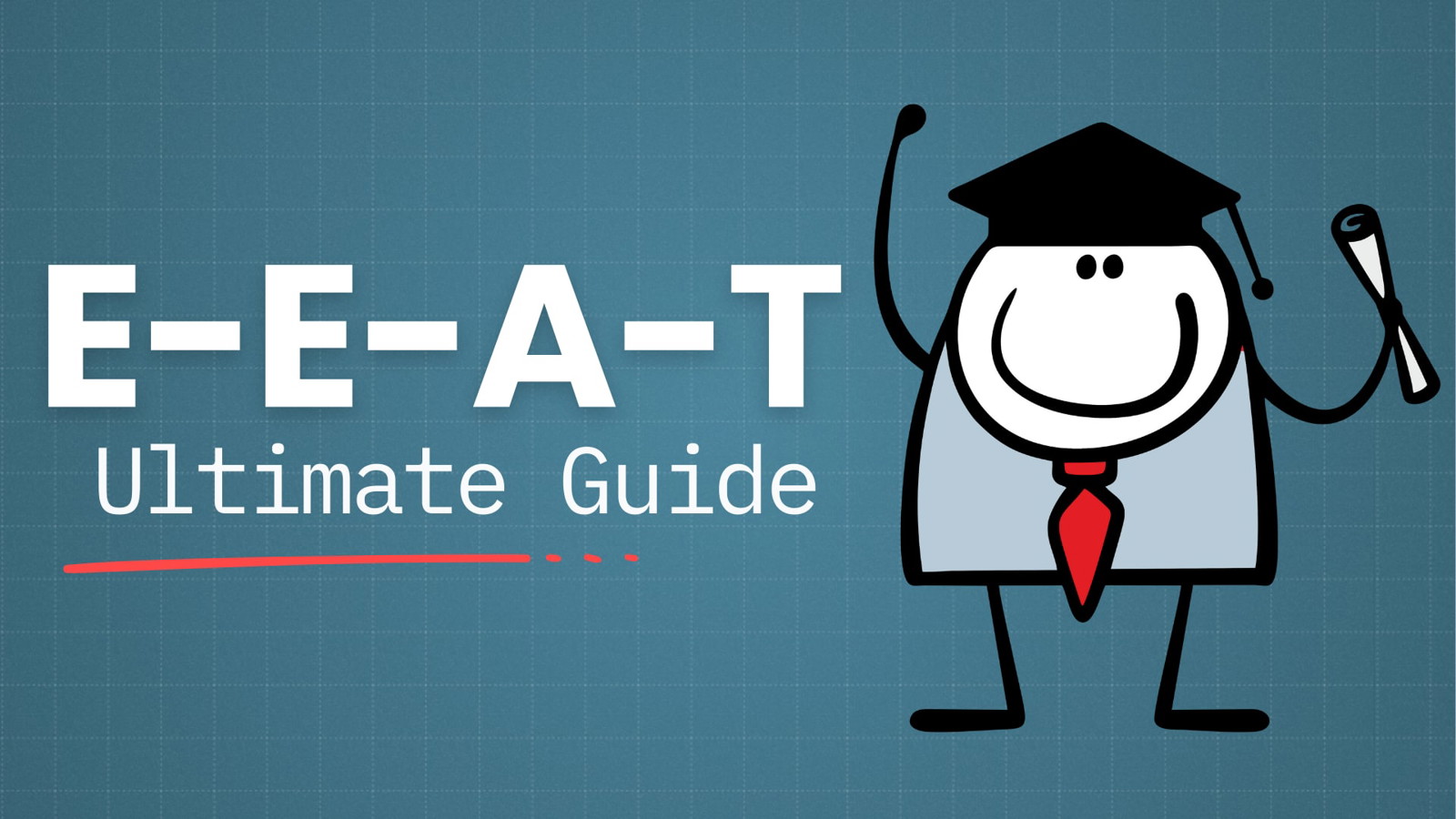Every time I hang out on SEO Facebook groups or blogs and see someone ask about the best link building techniques, it’s ALWAYS the same.
You get thrown a list of tactics that kind of work sometimes. You get NO details on how this actually works in real life and that’s it.
Figure it out.
And most people are fine with it because they don’t know any better.
Content creators do it because:
- It’s good enough to rank in Google anyway.
- You click on it anyway.
- Creators don’t really do this stuff and don’t actually know the details of it
No wonder that when we polled people, link building was by far the most challenging part of SEO for them.
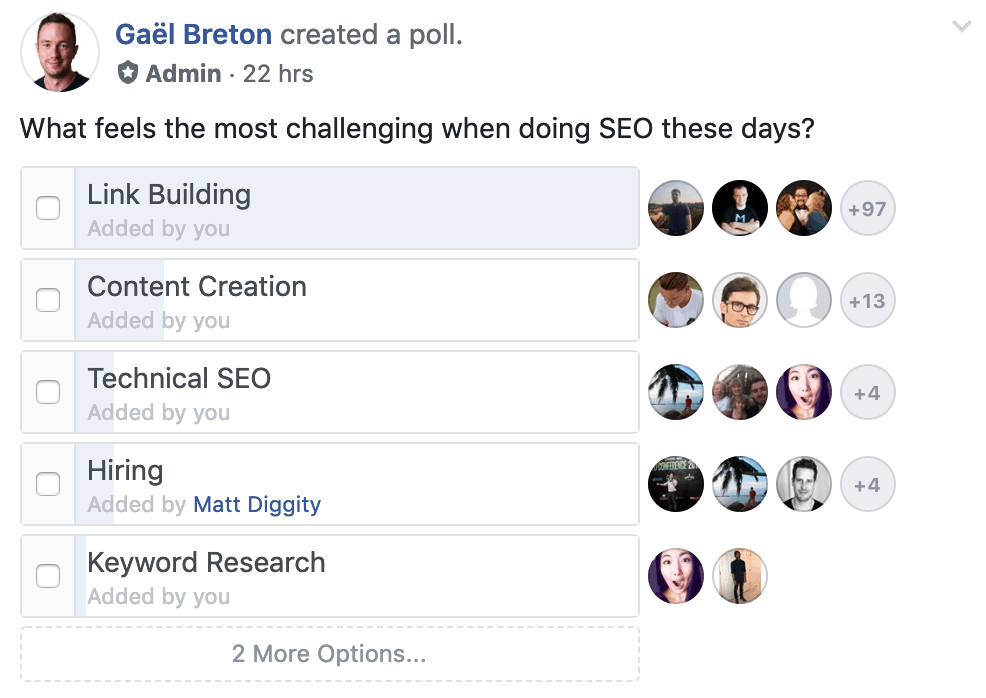
So in today’s blog post, I am going to ignore Google or even what you want.
I’m just going to give you what you need actually to succeed at link building:
Focus and details.
Stop chasing several tactics and learn how to be top 1% of all SEO’s at one of them. That is the key to unlock an unlimited amount of links for your business or your clients.
And this post will show you exactly how we got there.
This is the same system that we used for our recent 6 figure site flip case study.
The method we used to grow a brand new domain to a high authority site with tons of high-quality links from real sites, and ranking for quite competitive commercial keywords.
All of that without dropping a cent for links.
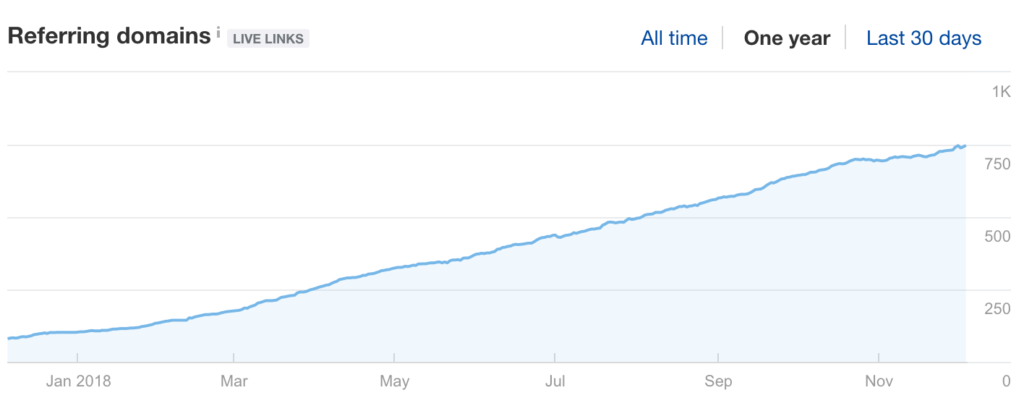
The method I am going to talk about today changes the game for a few reasons:
1. It’s simple
we focus on executing a simple process well rather than trying to land a rocket.
2. It’s scalable
you can obtain tens of thousands of links with this method.
3. It’s affordable
not only do we not pay for links but operational costs are low as well.
4. It works in pretty much every niche
if your competitors have links, so can you.
5. It’s outsourceable
and no, I’m not talking about Harvard graduates here, just regular VA’s.
Sound interesting?
Cool, let’s get to it…after a short history lesson.
Our Agency Days
For those of you who don’t know, Gael and I used to run a digital marketing agency in Budapest many moons ago.
The SEO scene there was booming, and we were doing pretty well for ourselves.
We had an overpriced office, a whole gaggle of people working for us, and about 90 clients.
Our link building process back then was grey hat, but then that’s what everyone else was doing.
The formula we used for creating links was super basic:
- Buy an article
- Spin it with software
- Blast it out to link networks
And we weren’t using anything posh like in-house PBNs.
Oh no, we used services like Linkvana, Article Marketing Robot and Build My Rank.
It was so easy and worked so well, we didn’t see any reason to change our approach.
So we didn’t.
Then in April 2012 Google Penguin showed up and turned the world of SEO on its head.
It actually felt a bit more like SEO got thrown down a few flights of stairs.
A lot of our clients got hit, which resulted in them quitting our agency.
Thankfully clients were easy to replace – the market was overflowing with panicked businesses looking for a solution to Penguin.

Now we had to find a new way to build backlinks.
We had two choices:
- Find a way to rank while staying off Google’s radar
- Figure out this white hat SEO stuff and stay within Google’s ToS.
We chose #2 because trying to stay ahead of a multi-billion dollar company with near-infinite resources just…well…seemed like a lot of work.
Guest Blogging 1.0
Our next foray into link building was to use guest blogging.
We promised ourselves we’d stick to being a white hat SEO agency, no matter what.
We built systems for everything we did and got our clients lots of links on other sites via guest blogging.
But…
Anyone who has ever done outreach for guest posts will know that blog owners aren’t shy about asking for cash.
Initially, we paid for some posts but negotiated for the rest of our link placements.
The problem was our outreach team figured out that we were willing to pay for links.
So instead of hustling, they’d just offer to pay the blog owner for them.
They got lazy.
But we were also facing client deadlines that we couldn’t afford to miss, so we subconsciously turned a blind eye to it.
It didn’t take long before we were paying for most of our links.

That put us squarely back in grey hat territory, and at risk of pissing Google off, again.
Of course, the market became saturated with companies selling guest blog posts.
Everyone was trying to undercut everyone else – it got vicious.
Instead of charging $50 for a guest blog post, some bottom-feeder would charge $10, and then somebody else would ask for $7.50.
The race to the bottom had begun.
And then it turned out Google didn’t like paid link placements:
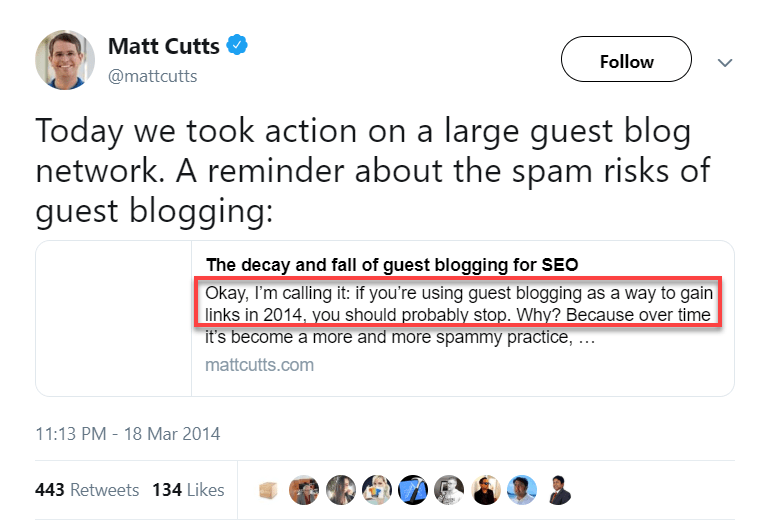
Who knew…apart from absolutely everyone!
By this stage in our marketing career a few things had happened:
- We were sick and tired of getting dinged by Google
- Gael and I had a serious dose of “client fatigue”
- We wanted to be legit marketers and not just link slingers

Authority Site Shenanigans
Gael and I always kinda knew we’d eventually move away from agency work.
Client working is exhausting and we’d had enough of it.
That’s why we’d started building authority sites as a side project while still running the agency.
We then sold the agency once our sites started making a 4-figure income per month, and went full time with building authority sites instead.
Link building was still an issue for us though because we didn’t have a system we could scale.
And without that system, our authority sites were going to need a lot of time and money invested in them.
It was around this time that a worrying number of white hat SEOs started perpetuating the myth of, “Oh, just publish great content and you’ll rank because Google loves great content”.
We initially fell for that line.
Until we tested their theory (they always have theories) and proved it was wrong.
Our grey hat Spidey senses had been right all along.
Then Brian Dean dropped his famous Skyscraper method article.
We tested his idea, Authority Hacked it and came up with our own version of it – one that worked for us.
In fact, it worked so well that it put every other link building system to so much shame they should have been marched naked through the streets of King’s Landing.
But I digress.
Gael and I had created the Shotgun Skyscraper Method.

Avoiding Shiny Object Syndrome
Before we go any further let’s take a moment to put a myth to bed, forever:
There are no secrets to building white hat links.
We hate to burst anyone’s bubble, but it’s the truth.
Yet people spend months (or years) searching for some kind of silver bullet that will just magically create links for them.
It doesn’t exist.
Professional link builders do well because they identify and master one link building strategy.
You don’t see them continually jump from one link building method to the next.
No, instead they continually refine and improve their process until it’s absolutely fluid.
The truth is most people have no idea how to build good backlinks at scale.
We see it over and over again – people hear about a link building tactic, talk about it passionately, test it for a bit and then stop using it.
It didn’t work straight away, so they stomp back to the forums and Facebook groups looking for “the secret”.
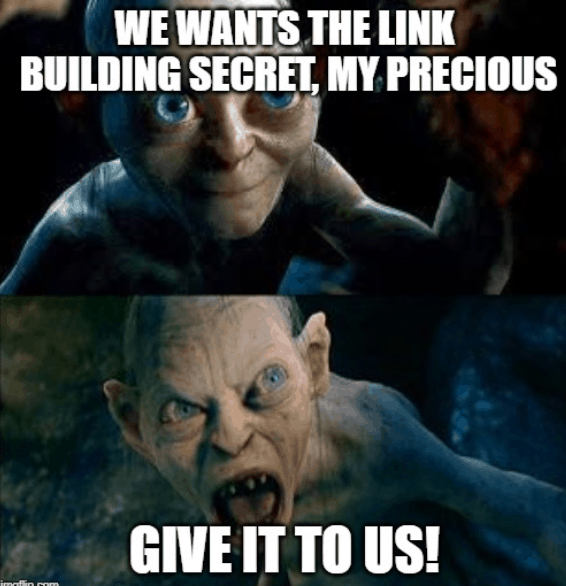
But there are no secrets.
There’s no magic formula or push button software.
That’s all crap.
They’re a dream peddled by marketing gurus on YouTube – the same guys who would sell their own mother to pay for their next webinar.
Everything you need to know about link building can be summed up in one sentence:
Pick one method and execute on it until you master it.
That’s exactly how we perfected the Shotgun Skyscraper system.
And we’ll show you exactly how to master it (in detail), but keep reading for now.
Shotgun Skyscraper Overview
What Is Skyscraper Link Building?
The Skyscraper method involves first finding a piece of content with lots of links pointing to it.
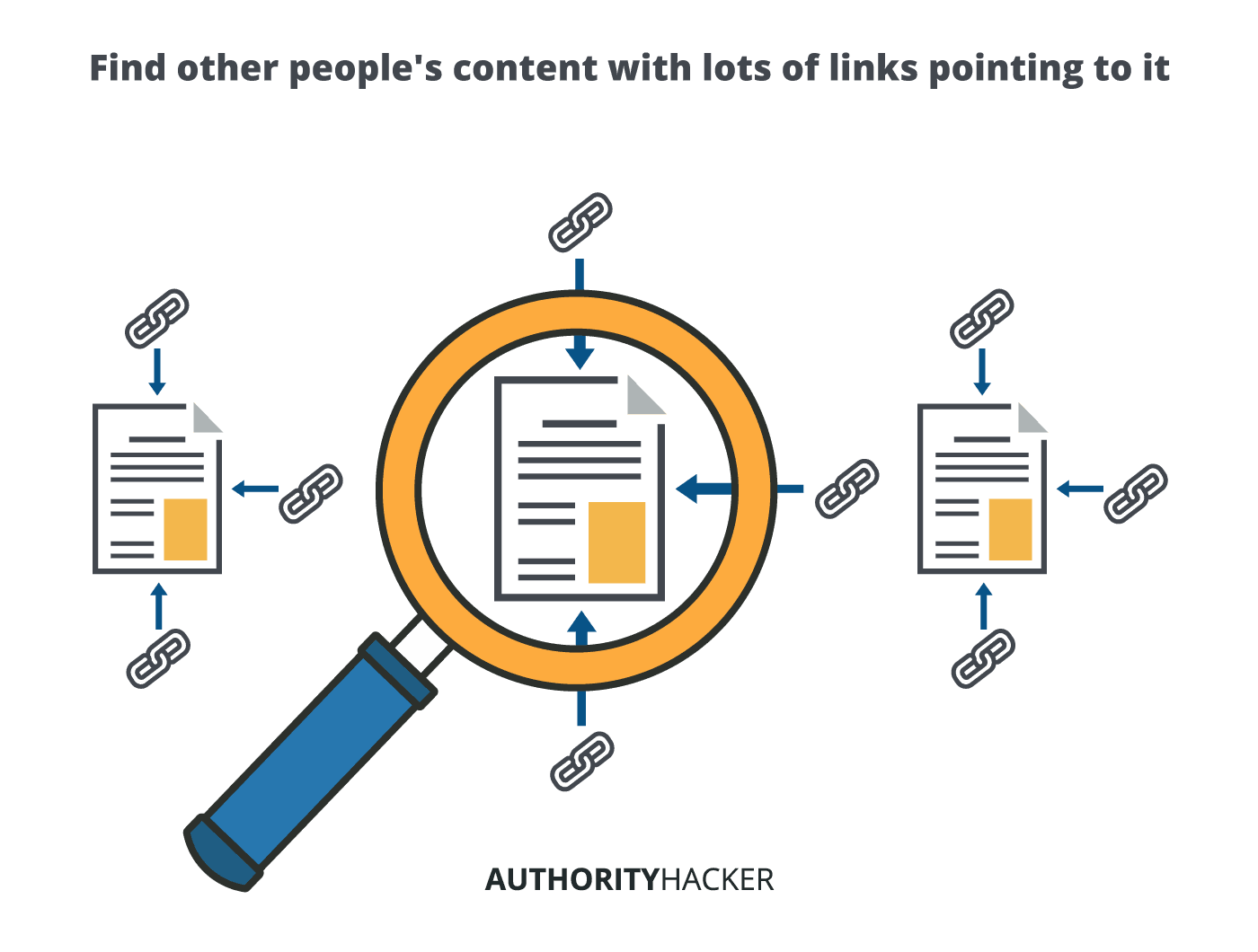
You then create a piece of informational content that is better than the original e.g. more in-depth, more media, etc.
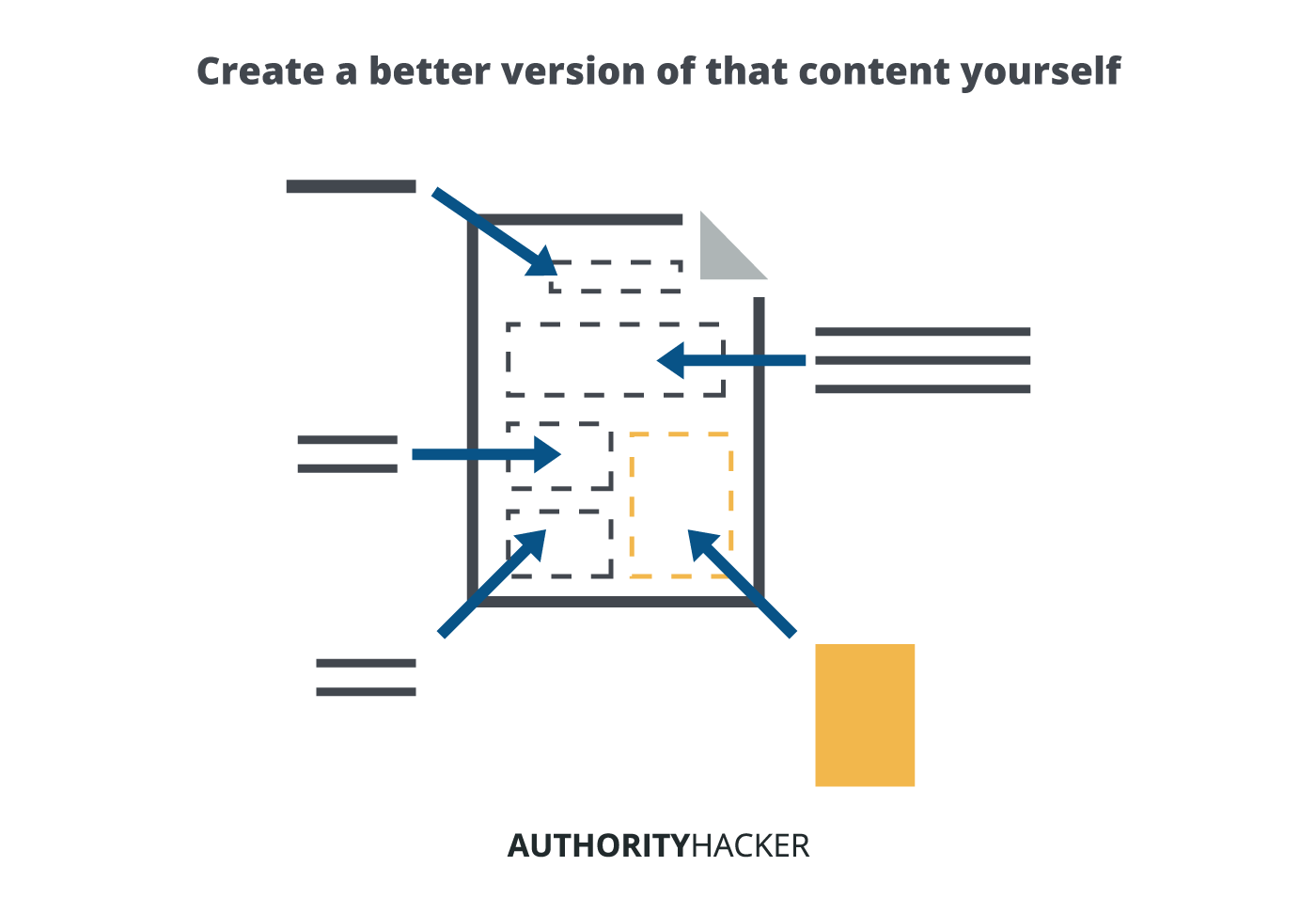
The next step is to reach out to the people linking to the original piece of content, asking them nicely to link to your new blog post instead.
There are many variants of the Skyscraper method, but the most commonly used is the “Sniper” approach.

Using the Sniper Method involves sending personalized emails to every single site owner linking to your competitor’s content.
This method works, but it’s extremely time intensive!
Even if you only spend 10 minutes per email, that means you’ll max out at 48 emails per day, assuming you can dedicate 8 full hours to the process.
How Shotgun Skyscraper Works
The Shogun system is different from the Sniper method because we automate our outreach emails.
Basically, we use templates (via Mailshake) to send 50x as many emails, but they’re semi-personalized.
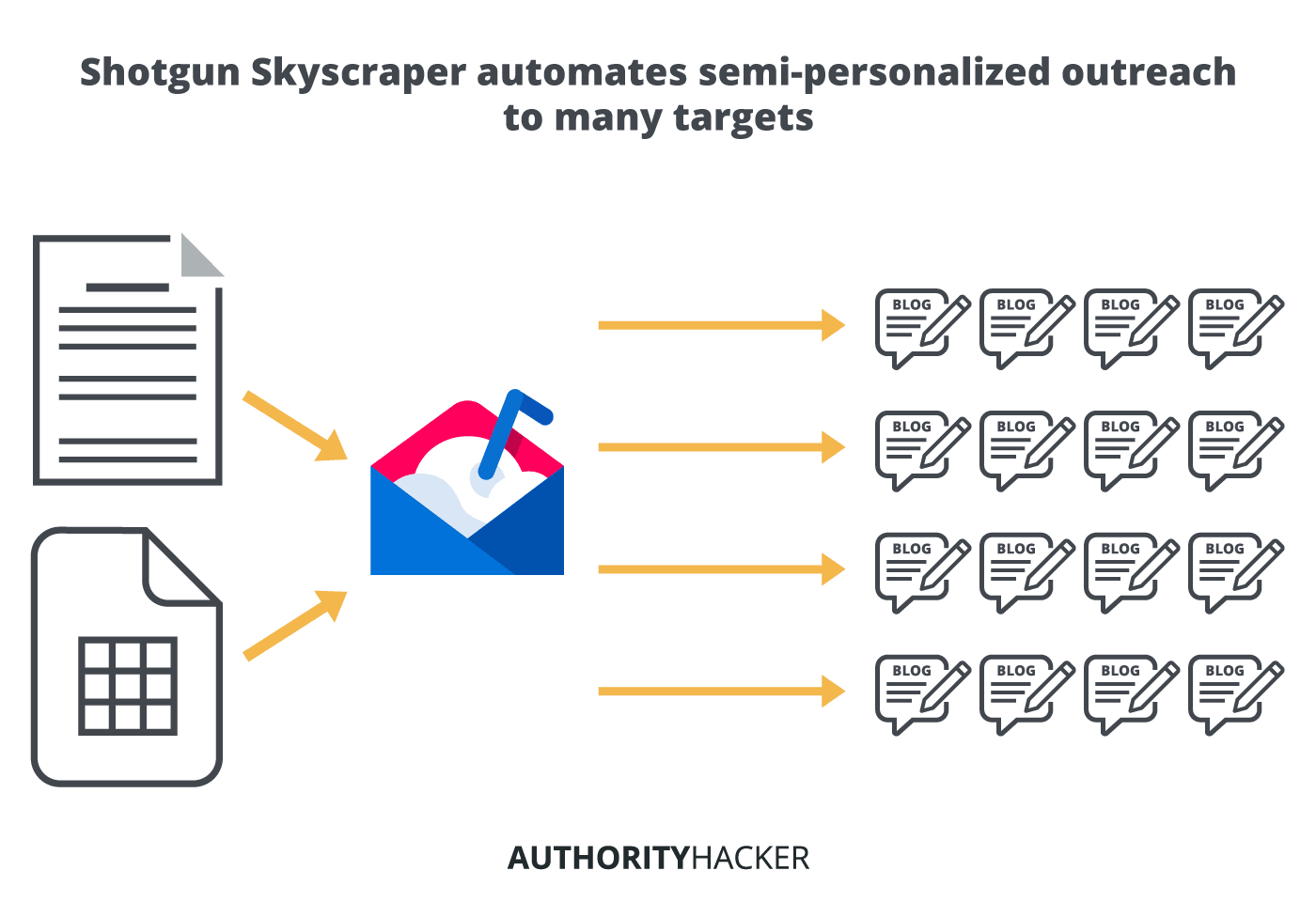
This allows us to send hundreds of emails per day where others struggle to send dozens if they’re lucky.
While the “sniper” might spend hours lining up the perfect email “shot”, we’ve been busy with the email marketing equivalent of an AA12 semi-auto shotgun.
Does this mean we have a lower response rate when compared to personalized emails?
Sure, but it also means we get 1667% more links because we take a volume approach.
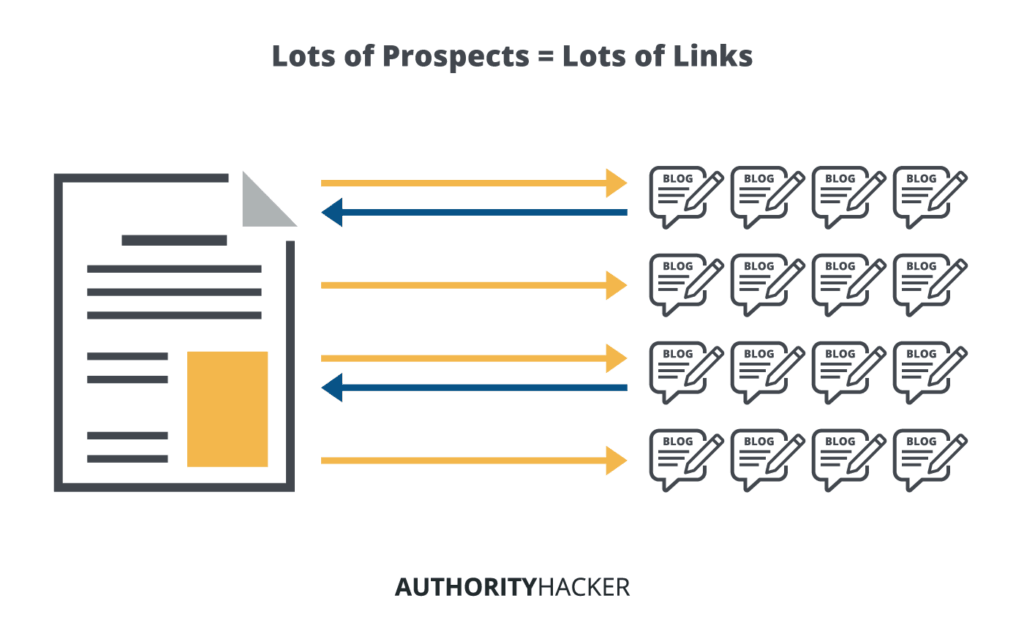
It also takes up far less of our time, so we can invest more time with each warm link prospect.
Theories are all well and good, but the only way to really test any link building process is to implement it on a brand new website.
So that’s exactly what we did.

As you can see, it worked like a charm.
Shotgun Skyscraper Keyword Research
The prevailing wisdom when it comes to keyword research is to choose keywords with very little competition.
How competitive keywords are is typically referred to as their keyword difficulty (KD) score.
A keyword with a lower KD score is usually easier to rank for in Google.
But Shotgun Skyscraper means doing things differently.
We’re actually looking for keywords with a high KD score.
Why?
Keyword Difficulty is a measurement of the number of links pointing to the top 10 results in the SERPs for a given keyword.
Shotgun Skyscraper is most effective when we have lots of sites to contact, and a keyword with a high KD score means our competitors have tons of links.
Note: Our focus is not to rank our Shotgun Skyscraper content – we’re using it to get more links to our domain so we can then funnel that “juice” to our money pages.
How to Find Good Keywords
We use Ahrefs (review) for our Shotgun Skyscraper research, so we’d recommend you do the same.
It’s not cheap if you’re just starting out, but it speeds the entire process up so much it becomes invaluable.
We start our keyword research using a broad keyword as the basis for finding “Question” keywords with a high KD score later on.
Note: You’ll need to use the V2 version of KW Explorer to be able to follow along with what we’re doing here.

Our broad keyword is “acid reflux”.
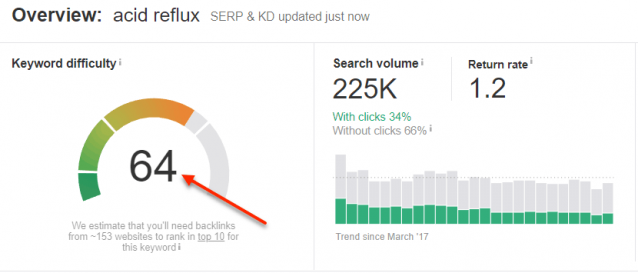
It has a KD score of 64 which is at the higher end of difficulty, but that also means our competitors’ pages will have a ton of backlinks to them.
That’s exactly what we’re looking for.
Now we need to make sure this keyword has plenty of informational content published on it.
The reason we’re looking for informational content is that it’s easier to get links to than “money” pages.
The quickest way to check for this type of content is the ‘Questions’ section of Ahrefs Keyword Explorer:

One keyword that looks interesting is “How to get rid of acid reflux” because:
- It’s competitive
- It’s informational
- It’s not a bad choice for skyscraper method content
And as you can see, the competing blog posts have a large number of backlinks, but not so many that it would take forever to contact them.
Basically, a few hundred backlinks are ideal, but a few million…no…just no.
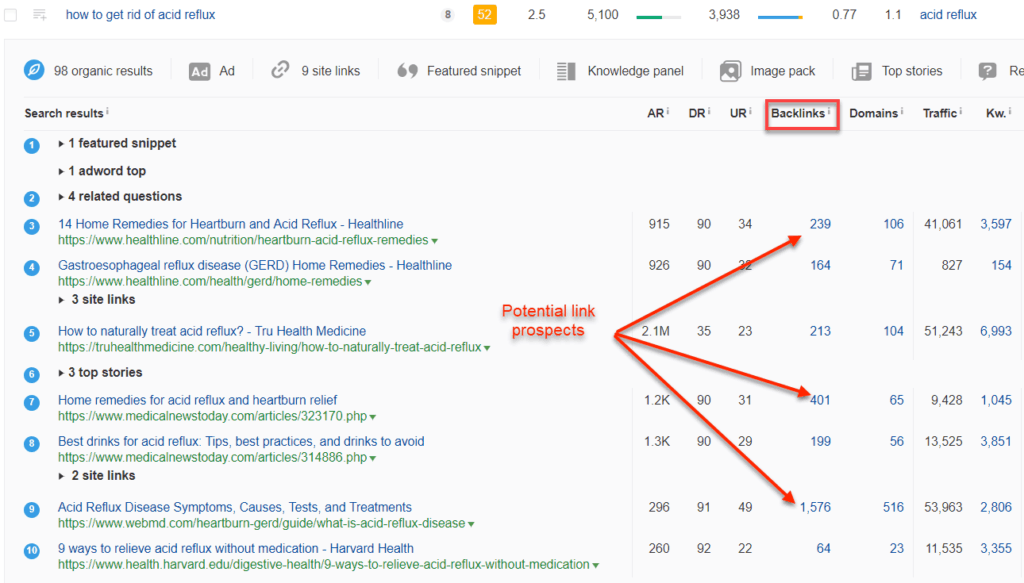
The data above is just for the top 10 results.
What we suggest is that you export the top 100 results from Ahrefs as a .csv file.
You then take each URL and run it through Ahrefs Site Explorer to find exactly what sites are linking to it.

After all, if these pages are linking to a competitor’s article, they’re quite probably willing to link to your article on the same subject.
Or at least they will be if your content is worth linking to, which we cover in the next section.
Once Site Explorer displays its results, click on ‘Backlinks’ from the left-hand menu.
Then to refine your results choose ‘One link per domain’ and also filter the links by ‘Do Follow’:
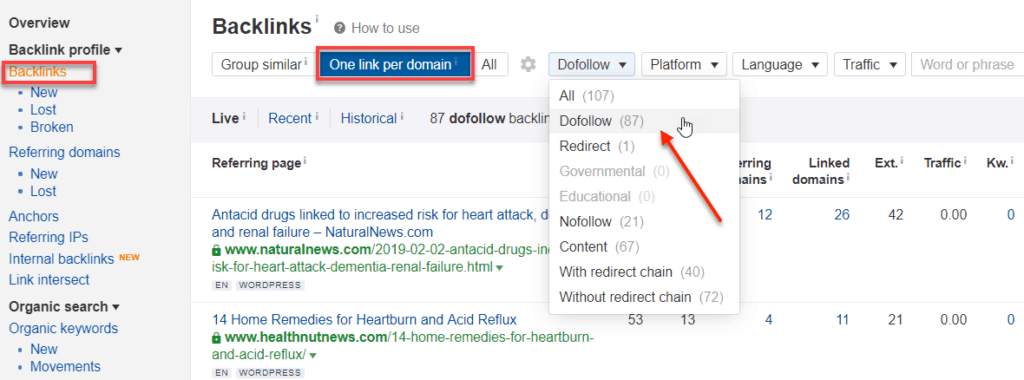
That leaves us with 87 websites to contact simply by analyzing a single URL.
Now click on ‘Export’, ‘Quick Export’ and then ‘Start Export’.

Once you’ve opened the .csv file, the column you’re interested in is ‘Referring Page URL’ – these are the pages linking to your competitor’s article.

Repeat this process for the top 100 URLs you exported earlier on, and then assemble all those ‘Referring Page URLs’ into a “master” sheet or document.
Creating Skyscraper Content
One of the most overlooked aspects of the Skyscraper method is content quality.
Far too many marketers skim articles on how the Skyscraper method works, but without truly understanding it.
A typical example is when the average content publisher thinks they can put out a 5,000-word piece of fluff, and people will fall over themselves to link to it.
That’s never going to happen.
Your skyscraper page needs to be a valuable piece of informational content that is significantly better than your competitor’s page.
It should touch on all the key points mentioned in your competitor’s blog posts but expand on them where necessary, as well as providing current information on the topic.
The additional “value” you provide can also come from providing content that’s easier to read through improved formatting, by adding relevant images, or maybe even including a short video.
Every element of your content should say, “I’m definitely worth linking to because I’m the best post you’ll find on this topic”.
Here are a few pointers to keep in mind:
- Do not use pop-ups on these pages
- Do not insert affiliate links anywhere on them
- Do not add “filler” content to hit some mythical word count
- Do add mixed media e.g. images, infographics, video
- Do make it the best free, high-value resource on a topic
How to Find Email Addresses
Your next job is to find the email addresses for the several hundred sites you identified in our last step.
You can choose to do that manually, which means checking out key pages of websites (contact, about, personal), and sometimes going as far as checking the source code for “mailto:” tags.
Hint: You’ll be amazed at how many email addresses you’ll find on the ‘About’ section of business Facebook pages

But once you’ve harvested a few hundred addresses manually, you’ll start to feel a bit like this:

So we needed to make our email discovery process way more efficient…to avoid meltdowns.
Each email only took about 2 minutes for us to find.
But when you have to find 1,000 emails those 2-minute blocks turn into 33 hours (or 4 days) of mind-numbing work.
That’s why we use Hunter – it does in seconds what it used to take us days to do.

Hunter uses multiple sources of publically available data to locate email addresses attached to any domain.
Instead of manually looking up email addresses we can upload a list of URLs into Hunter in .csv format.
This is the same information we exported from Ahrefs earlier on:
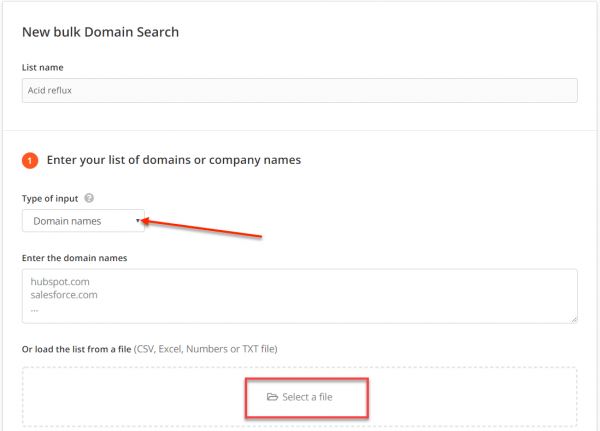
Hunter processes your request in the background and then spits out a list of valid email addresses.
Note: You can also use Snov.io as a budget alternative to Hunter, but the results are nowhere near as good.
Just in case anyone is wondering, yes you can use Scrapebox to help automate your email gathering – that’s all part of the advanced stuff we’re now happy to share with you later on.
How accurate is Hunter?
We typically find that anywhere from 30-60% of the email addresses are valid.
But what about the other 40%+ of emails Hunter can’t track down?
We strongly advise that you keep these URLs in a separate sheet and either look for them manually or use other tools.
Why bother doing that?
Because our data shows that the response rate from these “hidden” addresses is usually pretty high.
Hunter has saved us hundreds of hours of painstaking work by automating the bulk of our email gathering.
Does it have any downsides?
One – it can generate up to 10 different addresses for a single domain.
Once upon a time, we used a bespoke (we paid cash for it) Excel macro to figure out the “best” email address to use when Hunter gave us several.
The macro itself actually worked pretty well, but there were some issues:
- It crashed way too often, especially on large (20k) lists
- We had to wait at least an hour to get results
These are snags that held up this part of our process, so we had to come up with a fix.
We now have a script that does all that hard work for us, and it does it in seconds.
Seconds vs. hours = a far more efficient outreach system.
And if you want access to that script all you have to do is keep reading all the way to the end.
Shotgun Skyscraper Outreach
We exclusively use Mailshake for all of our outreach work – a decision we arrived at after testing pretty much every other tool on the market.

We prefer Mailshake for a number of reasons but the main ones are that it has better cross-team features, and the data reporting is ideal for what we need.
We call our link building process “Shotgun Skyscraper” because we’ll queue up 5,000 emails to link prospects in a day instead of 50.
Link outreach is a numbers game, whether you like it or not.
Our logic has always been that it’s better to get 5% of 1,000 site owners to link to you than 25% of 50.
But the only way we can manage outreach email at this scale is to use templates and the power of Mailshake.
This is basically the same as doing an old school mail merge in that we’re taking a data source (the Referring URL pages from Ahrefs and email addresses from Hunter) and combining them with an email template.
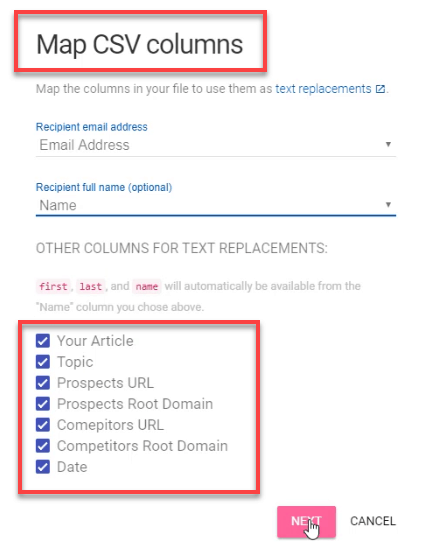
Does that mean we’re spamming people?
No – we personalize every single outreach link email we send.
How?
By using templates, of course ☺
Here’s an example of a typical template we’ve used in the past:

The highlighted areas are fields where the information from our data source is merged with the content of the template e.g. their name, the piece of content we want a link from, the shotgun skyscraper post we want a link to, etc.
As you can see, we keep it short and to the point, but also as personal as possible.
Hint: Including a person’s first name in an outreach email will improve your overall response rate.
We also played around with email signatures a little too. Turns out, they don’t make a huge difference when it comes to cold outreach, although it’s a different story for other types of outreach.
Do we only contact a link prospect once?
Nope – we typically send 3 emails to each prospect before we write them off as a lost cause.
The reason for this is because, after analyzing our data, we noticed that 48% of our links came from follow-up emails.
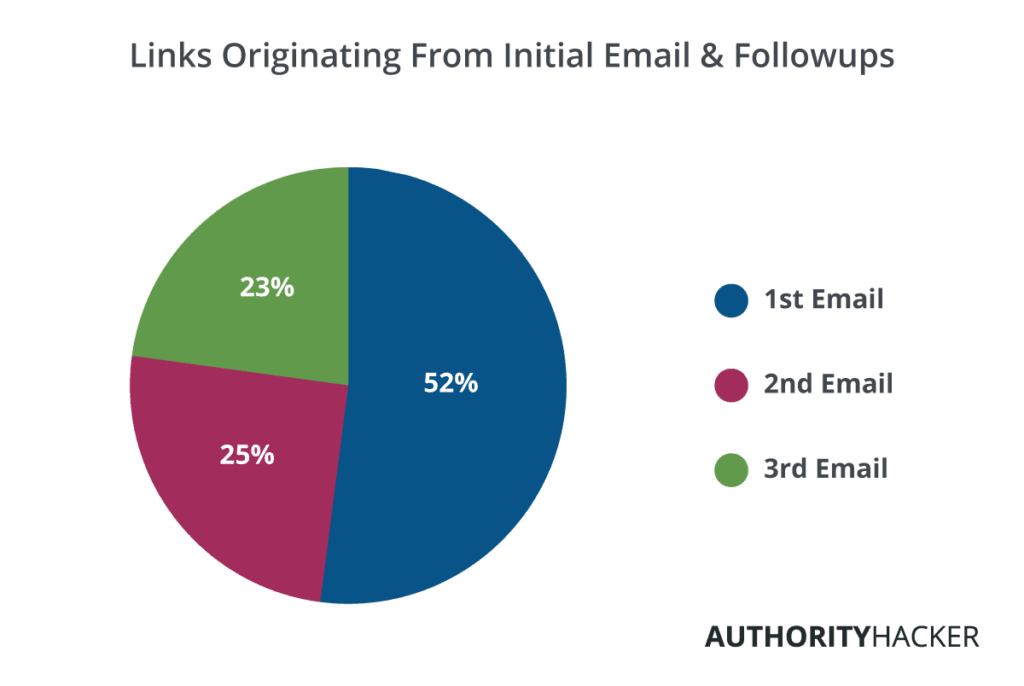
Obviously, if their initial reply was to tell us to go and acquire intimate carnal knowledge of ourselves, then we don’t contact them again.
But imagine missing out on 48% of your links because you didn’t send a follow-up email?
That’s exactly what the majority of “skyscraper marketers” do every single day.
Arghhhhhh!!
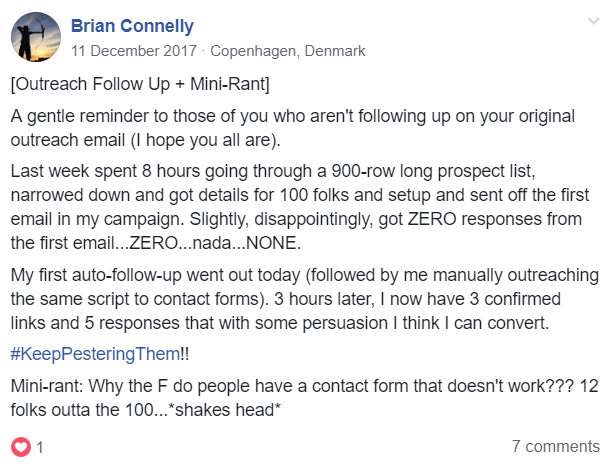
The other very neat part of this part of the process is Mailshake handles the follow-up emails for us.
All we have to do is specify “Send follow-up in x days” and it takes care of the rest.
It also removes an email address from our campaign sequence if the person replies to us.
The Negotiation Phase
In an ideal world, every person you email for a link would reply with, “Sure. Great idea – we’d be happy to.”
What actually happens is something more like this:

You’d be amazed at how many blog owners vastly overestimate the value of their digital real estate.
Not that we really care if you want to pay for links.
We know it is a reality of the market and that many of our competitors do it.
Just know that you don’t have to if you play your cards right which can both save you money and trouble from Google.
This is where learning how to negotiate for links can really pay off.
For the replies that ask for a payment, you should immediately change the conversation, steering it away from money and instead talk about “…collaboration” or “…adding value for their audience”.
We never pay for links or link placement, because we’ve learned that, with a little perseverance, you can often get the link for free.
Or, at worse, offer them a guest post to publish on their blog.
Do we sit down and write each of these replies personally?
Hell, no!
We use “canned responses” instead – these take seconds to send instead of minutes.
You see, 80% of the replies we get from link prospects fall into a handful of categories such as:
- Paid links
- Link exchanges
- Guest post pitch
And each of those “reply categories” is ideal for a canned response because there’s a limited number of ways we can say “No, thanks” or “Yes, please”.
Our canned response for sites that flat-out demand paid link requests is typically along the lines of, “Sorry, but we never pay for links. Thanks for getting back to us, and have a great day.”
If, on the other hand, they say something like, “Well we normally ask for payment for links…” that indicates they might be open to a guest post pitch.
In those situations, we hit them up with the “Guest blog post” canned response.
We know some of you might feel weird about sending canned responses, but look at it this way, would you rather:
a) Spend 15 minutes typing out a personal reply; or
b) Spend 15 seconds sending a reply that has the same effect?
When you create templates the right way they’ll both look and feel genuine and personable.

You can still take a few seconds to add a personal touch to each canned response.
Anything that makes you look and sound more like a real person will usually have a positive impact on your response rate.
Your focus should be on making the most of your conversation with this link prospect.
Shotgun Skyscraper has drastically reduced the amount of time needed to start the conversation, so you owe it to yourself to invest that time wisely.
It’s Just Another Funnel
I know that was a lot to take in at once – we dumped years of hard-earned knowledge into one blog post but really, this is just the tip of the iceberg.
The best way to think about this method is to think of it as a funnel.
Yep, like a sales funnel.
I know the hardcore SEO’s are already rolling their eyes but humor me for a second here.
If you start thinking of this process as a funnel, it gives you the mindset you need to really take this to the next level.
Here is a visual representation of the process I just outlined to you:

Each step is a yes or no test that filters people down further towards your ultimate goal: getting a link.
Now that we have broken it down, you can take each of these steps, say “people who open your emails” for example.
you can now pick as a metric to measure your success against for this step.
In this case, outreach email open rate.
And devise tests to optimize that step.
In this case, probably some kind of subject line a/b testing.
And this funnel visualization coupled with constant optimization and benchmarking is exactly what built the system we are sitting on today.
The system that allows us to take $10 domains and make them highly valuable in a short amount of time.
Once you have this system in place, outreach is just a numbers game.
The more potential link prospects you can “pour” into the top of your funnel, the more likely you are to have lots of free link placements filtering out at the bottom.
We’ve broken each stage into its own process, created SOPs for them, and then hired people to perform each task for us.
That is the only way you can hope to do white hat link building at scale.
But we still test, tweak and optimize each stage of the funnel if we think we can make it more efficient.
If there’s one lesson I’d like you to walk away from this blog post with, then it’s this:
Jumping from one link building tactic to another will guarantee you never get the results you want…but being top 1% of the world at one of them will.
So…What’s Next?
We’re pretty sure you can see by now just how powerful our system is.
We know that where most people struggle is having a plan to follow, and step-by-step instructions.
And that’s why we’re releasing the Shotgun Skyscraper Blueprint in just a few days.

In the blueprint, we go into way more detail on each step of the process, guiding you every step of the way.
In the Shotgun Skyscraper Blueprint you get:
- 7 core modules
- 45 over-the-shoulder videos
- 20,000 words of supporting content
- A whole catalogue of outreach templates
- Pre-built spreadsheets and databases
- Pre-written job ads to help hire your team
- Advanced tactics not shared anywhere else
- Our secret “Email picker” tool
The blueprint includes every single step is done and recorded over the shoulder, click by click in 100% actionable no fluff videos.
You see us run real-life campaigns on our sites.
But maybe you are busy or technophobic to learn how to Shotgun?
No sweat – our blueprint provides you with everything you need to find, hire and train your outsourced team.
You just need to manage them after that.
Even if your content is a bit “Meh” right now, we show you how to create high-quality skyscraper pages. Or you can just use our SOPs to outsource the work to somebody else.
Is Shotgun Skyscraper the most powerful white link building system out there?
from what we know, “Yes”.
It works for any website, in any niche.
It works for regular blogs, e-commerce sites, lead gen sites, affiliate sites, etc.
A more primitive version of this is also used by many white hat link building services. We’ve spoken to agencies like LinkBuilder.io who do this stuff for a living and they agree that the Skyscraper method opens a large number of opportunities that you just don’t get using other techniques.
But sometimes it’s just best to let some of our AH PRO members who’ve used a previous version of Shotgun Skyscraper do the talking:

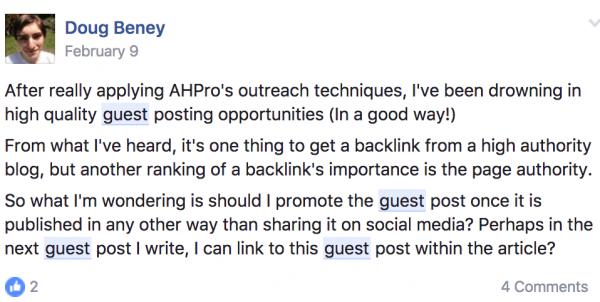

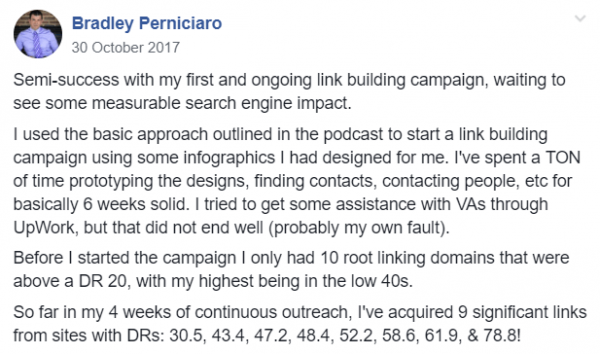


Get access to the exact same system we used to sell an 18-month old site for mid-6-figures. The Shotgun Skyscraper Blueprint will be released this Sunday.
So if you want more information on the upcoming blueprint, make sure you are signed up for our newsletter and watch out for the announcement coming out soon.



